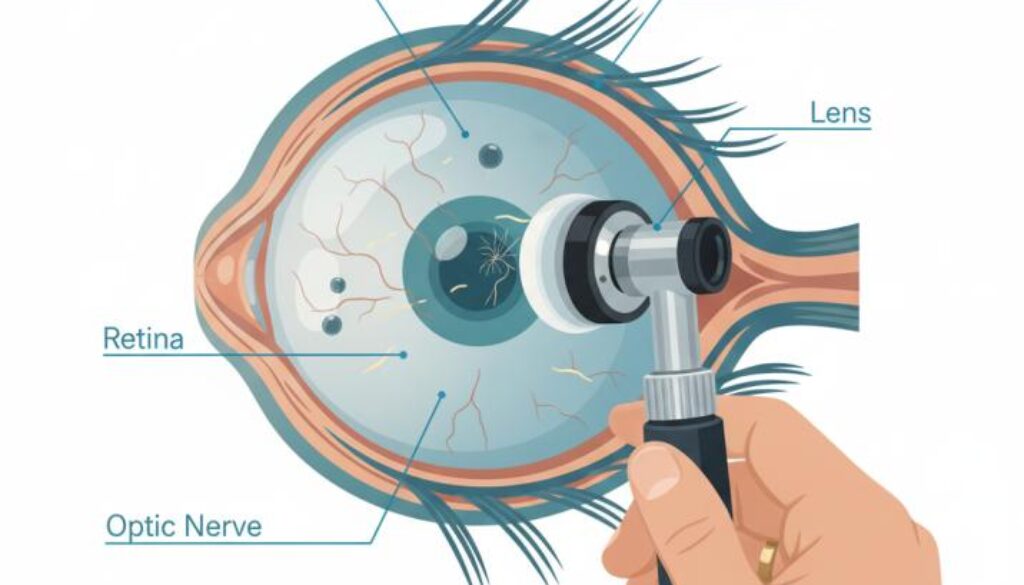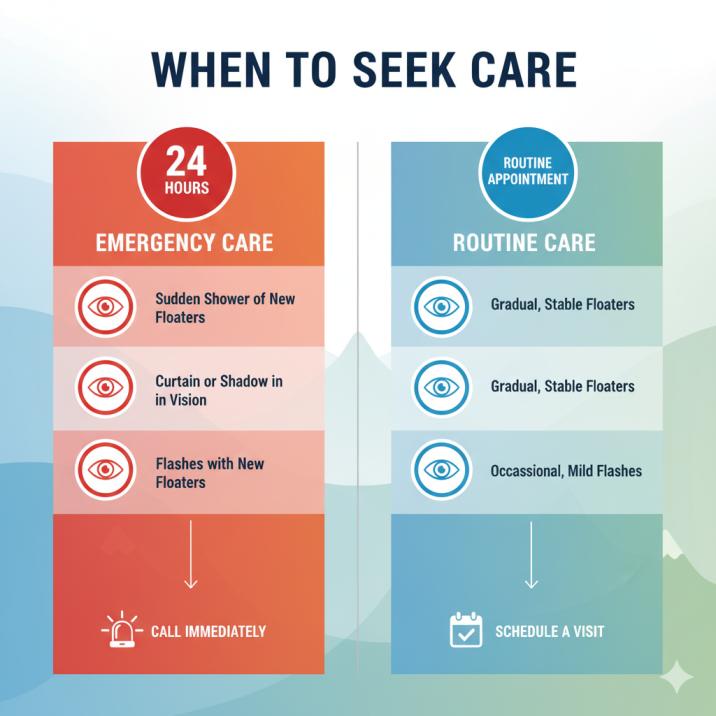Flashes and Floaters: When to Rush to the ER vs. When to Wait
Quick Answer:
When Are Flashes and Floaters an Emergency?
🚨 SEEK EMERGENCY CARE WITHIN 24 HOURS: Sudden shower of floaters, curtain/shadow in vision, flashes with new floaters, or any vision loss. These may indicate retinal detachment.
✅ ROUTINE CARE IS APPROPRIATE: Gradual, stable floaters unchanged over months, occasional mild flashes if over 50, or symptoms only with migraines.
Understanding Flashes and Floaters: Your Complete Guide
Experiencing sudden flashes of light or dark spots drifting across your vision can be frightening. While these visual disturbances—medically known as flashes and floaters—are often harmless signs of aging, they can also signal serious retinal detachment requiring immediate medical attention.
As Fort Collins’ most experienced eye care practice with over 25 years serving Northern Colorado families, Poudre Valley Eyecare helps you understand when these symptoms require emergency care versus routine evaluation. Making the right decision can literally save your sight.
What Are Eye Flashes and Floaters?
Eye Floaters Explained
Floaters are small, dark shapes that drift across your field of vision, appearing as:
- Tiny shadows, specks, or dots
- Cobweb-like strands or threads
- Ring-shaped or curved lines
These visual disturbances occur when tiny clumps form in the vitreous—the clear, gel-like substance filling your eye. As light passes through your eye, these clumps cast shadows on your retina, creating the appearance of floating objects.
Eye Flashes Explained
Flashes appear as brief bursts of light, typically described as:
- Lightning-like streaks or zigzags
- Camera flash-like bursts
- Sparkles or twinkling lights in peripheral vision
Flashes occur when the vitreous gel pulls on or rubs against your retina. This mechanical stimulation sends false light signals to your brain, creating the perception of flashing lights even when no actual light is present.
Emergency vs. Routine Care: Making the Critical Decision
The difference between a vision-threatening emergency and normal aging changes depends on three key factors: suddenness, quantity, and accompanying symptoms. Understanding these distinctions is crucial for preserving your sight.
When to Seek Emergency Eye Care Immediately
“Time is vision when it comes to retinal detachment. Every hour matters.”
⚠️ EMERGENCY SYMPTOMS – Seek care within 24 hours if you experience:
- Sudden shower of new floaters – Multiple dark spots appearing all at once, often described as “a waterfall of floaters”
- Dark curtain or shadow in vision – A growing dark area covering part of your visual field
- Flashes with new floaters – Bright peripheral flashes accompanied by new dark spots
- Sudden vision loss – Any rapid decrease in vision clarity or peripheral vision
- One large new floater with flashes – Prominent dark spot that wasn’t there before
Recent research confirms that early intervention within 24-72 hours significantly improves retinal detachment repair outcomes. Studies show that patients with macula-attached detachments achieve 20/40 or better vision in approximately 83% of cases when treated promptly, emphasizing the critical importance of immediate evaluation.
When Symptoms Can Wait for Routine Care
✅ These symptoms typically don’t require emergency care:
- Stable floaters unchanged for months or years
- Occasional mild flashes during eye movement (especially if over 50)
- Gradual increase in floaters over many months
- Small, transparent floaters that come and go
- Visual disturbances only with migraines
Retinal Detachment: Why Every Hour Counts
Retinal detachment occurs when your retina—the thin, light-sensitive tissue lining the back of your eye—separates from its normal position. This separation cuts off the retina’s blood supply, causing affected tissue to die if not reattached promptly.
The Time-Critical Nature of Treatment
Current medical research emphasizes that retinal detachment repair outcomes are measured in days, not weeks. There’s a critical treatment window of 0-3 days where prompt reattachment, especially when the macula (central vision area) remains attached, can result in dramatically better visual outcomes.
Studies show that approximately 8-16% of acute symptomatic posterior vitreous detachments result in retinal tears, with about 1 in 1,000 developing full retinal detachment. While these numbers may seem relatively low, the consequences of missing a detachment can be devastating.
Risk Factors: Who’s Most at Risk?
High-Risk Factors Requiring Extra Vigilance
- Age over 50 – Risk increases significantly due to natural vitreous changes
- Severe nearsightedness (myopia) – Elongated eye shape increases retinal stress
- Previous retinal detachment – History significantly raises the risk in both eyes
- Family history of retinal problems – Genetic predisposition plays a role
- Previous eye surgery – Cataract surgery and other procedures can affect the vitreous
- Eye trauma or injury – Even minor injuries can cause delayed complications
Treatment Options: How We Preserve Your Vision
When detected early, most retinal tears and detachments can be successfully treated. The specific approach depends on the type, size, and location of the problem.
Early Intervention Treatments
Laser Photocoagulation: For small retinal tears, laser treatment creates microscopic burns around the tear, forming scar tissue that seals the area and prevents progression to full detachment.
Cryotherapy (Freezing): This procedure uses extreme cold to create therapeutic scarring around retinal tears, particularly effective for tears in certain locations.
Advanced Surgical Interventions
Vitrectomy: This surgical procedure removes the vitreous gel and replaces it with a gas bubble or silicone oil to help reposition the retina. Success rates exceed 90% when performed promptly.
Scleral Buckle: A silicone band placed around the eye to push the wall inward, helping the retina reattach. This time-tested technique remains highly effective.
Pneumatic Retinopexy: For specific types of detachments, injecting a gas bubble combined with laser or freezing treatment can successfully reattach the retina with minimal surgery.
Your Emergency Action Plan
Immediate Steps for Emergency Symptoms
- Contact Poudre Valley Eyecare immediately: (970) 221-2222
- If after hours, go to the nearest emergency room
- Avoid driving if vision is significantly impaired
- Don’t wait to see if symptoms improve
- Bring the medication list and medical history
Prevention: Protecting Your Long-Term Vision Health
- Annual comprehensive eye exams (crucial after age 50)
- Protect eyes from trauma with appropriate safety gear
- Manage diabetes carefully to prevent diabetic retinopathy
- Know your family eye health history
- Monitor symptoms if you have risk factors
Fort Collins Eye Care: Serving Our Community’s Unique Needs
For Working Professionals (Ages 35-65)
Fort Collins professionals often dismiss new floaters as work stress or computer eye strain. However, this age group commonly experiences the first signs of posterior vitreous detachment. Don’t let work demands delay urgent eye care—your career depends on your vision.
For Active Seniors (Ages 65+)
Medicare covers essential retinal evaluations, and our practice accepts both Medicare and Medicaid for comprehensive care. Age increases retinal detachment risk, but early detection and treatment preserve independence and quality of life. Don’t let transportation concerns delay urgent care.
Scientific References and Medical Citations
This evidence-based guide incorporates current peer-reviewed research and authoritative medical sources:
- Blair, K., & Czyz, C. N. (2024). Retinal Detachment. StatPearls Publishing.
https://www.ncbi.nlm.nih.gov/books/NBK551502/
– Comprehensive review including visual outcome statistics. - Nixon, T. R. W., et al. (2024). Posterior vitreous detachment and retinal tear study. Eye, 38(4), 786-791. https://www.nature.com/articles/s41433-023-02779-3
– Large prospective study on PVD complications. - Powell, S. K., et al. (2023). Emergency department presentations for flashes and floaters. Irish Journal of Medical Science, 192(5), 2527-2532.
https://www.ncbi.nlm.nih.gov/pmc/articles/PMC9851890/
– Emergency care utilization patterns.
Your Vision, Our Priority: Expert Care When You Need It
Understanding when flashes and floaters require emergency versus routine care can preserve your sight and peace of mind. While gradual, stable floaters are often normal aging, sudden visual changes—especially new floaters with flashes or any vision loss—demand immediate evaluation.
At Poudre Valley Eyecare, our quarter-century of experience serving Fort Collins families means we understand both the medical urgency of retinal emergencies and the anxiety they create. Whether you need emergency evaluation or routine monitoring, we provide expert, compassionate care when you need it most.
Don’t Wait. Your Vision Can’t Wait. Call Poudre Valley Eyecare Today.
Immediate appointments available for urgent eye concerns
Medicare & Medicaid Accepted • Serving Fort Collins for 25+ Years
Proudly serving Fort Collins, Loveland, Windsor, and all of Northern Colorado
FAQs
-
Eye floaters are small, shadowy specks or cobwebs drifting in your vision caused by age-related changes in the vitreous gel. Sudden new floaters may signal retinal tear or detachment requiring urgent evaluation.
Please note: None of the above should be considered medical advice. If you’re having any concerns about your vision, please reach out to us immediately or see your primary care provider.




